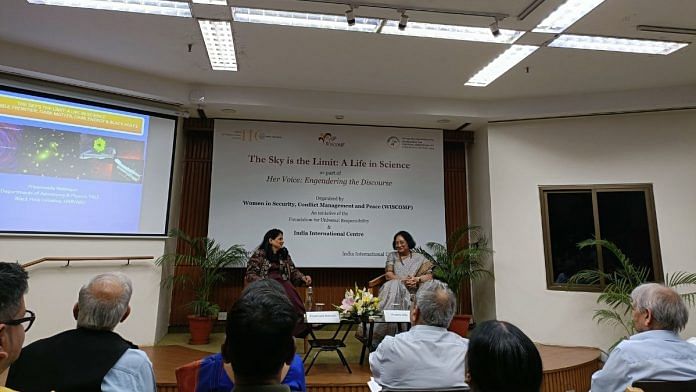New Delhi: When she was 17, renowned astrophysicist Priyamvada Natarajan mapped the night sky over New Delhi. In that moment she went from being just another “persistent child” to a “real scientist” in the eyes of Nirupama Raghavan, the then-director of the Nehru Planetarium.
“I was a kid with a Commodore 64 computer at home and I wanted to code,” said the scientist in discussion with Pratibha Jolly, former principal of Miranda House at the India International Centre.
“Raghavan had asked for just Delhi’s sky, but I, wanting a challenge, sprung for the skies of cities around the world,” added the 56-year-old with a laugh.
It was the first map that Natarajan had created, and the one that began her journey into the world of cosmology and mapping the universe. A professor and chair of the Astronomy department at Yale University, Natarajan’s pioneering work in black holes and dark energy has been validated by the James Webb Space Telescope.
Natarajan still wakes up each day drawn by the mysteries of the universe.
“What could I tell you about how science has seduced me?” began Natarajan, during her two-hour-long discussion. “As a child, my parents presented me with a telescope and a microscope and I just chose the former.”
In an event organised by Women in Security, Conflict Management and Peace (WISCOMP) on 13 March, Natarajan captivated a packed room in the IIC Annexe with tales from her life – her work in black hole origins, her journey from Cambridge to Yale, and the challenges of being a woman in STEM in the early 2000s. In the audience were people from all spheres, including current and former students of Delhi University who were avid fans of Natarajan’s life and work.
Another Tamil physicist in the US
Originally from Coimbatore in Tamil Nadu, Natarajan started the talk by discussing Subrahmanyan Chandrasekhar, another Indian scientist who moved to the US to study black holes.
“We’re so lucky to be living and working in times when our theoretical propositions can be validated in real time with real data,” she said. “I mean, even the great Subrahmanyan Chandrasekhar’s theories about black holes were validated decades after he had first proposed them.”
In 2007, Natarajan theorised about ‘heavy seed’ supermassive black holes that formed in the early universe through direct collapse of gas. This challenged the prevailing idea that black holes formed only through collapsing of stars—a view that had coincidentally first been proposed by Chandrasekhar.
Natarajan’s team of researchers in Yale mapped out the exact point in the universe where these heavy seed black holes could be found in 2017. They even defined what their characteristics would look like.
“Being a theoretical physicist, I was throwing out a lot of predictions into the world because that’s just what we do,” recalled Natarajan.
Six years later, however, NASA’s James Webb Space Telescope and Chandra Telescope both found compelling evidence proving exactly what Natarajan was working on. A heavy seed black hole with the exact properties she had described, formed in the early universe. When she got the call, Natarajan could barely control her excitement.
“My colleague who called to deliver the news asked if I was sitting down to hear it,” she laughed. “I mean, it is one thing to develop a theory, but something else altogether to see it be validated in your lifetime,” she said.
Also read: More Indian women in STEM but few are becoming leaders. Hard to retain them in workforce
Challenges and glass ceilings
It wasn’t always easy for Natarajan, who did have to contend with the fact that she was a young Indian woman in physics. She spoke about how often she was overlooked or not given access to research grants, for either being too young to being a woman.
“I finally persuaded the grant committee in charge of the Hubble Telescope to anonymise grant selections – so that the committee didn’t know whose proposals they were seeing, and the grantees didn’t know who was seeing their proposals either,” said Natarajan.
That year was the first time the largest proportion of women and young researchers got access to the Hubble telescope, and now the entire astronomy community uses this process of anonymised grants.
Toward the end of the discussion, the audience members badgered her with questions about starting a career in STEM, and overcoming the fear of failure.
Without downplaying the struggles marginalised communities face and the perks of privilege, Natarajan had simple advice for the inquirers.
“I often say I’ve been lucky to get where I am. But you must remember, the windows of luck will only open when you put in the work and push hard,” she said.
Jolly, while ending the conversation, recalled an incident from a few years ago when BBC had interviewed her and asked who she thought the next Einstein was going to be.
“I had told them that the next Einstein would be a woman, and she would be a daughter of Lilavati. I know now my prediction has come true,” she said, referencing the 2008 book about Indian women in STEM.
(Edited by Ratan Priya)






